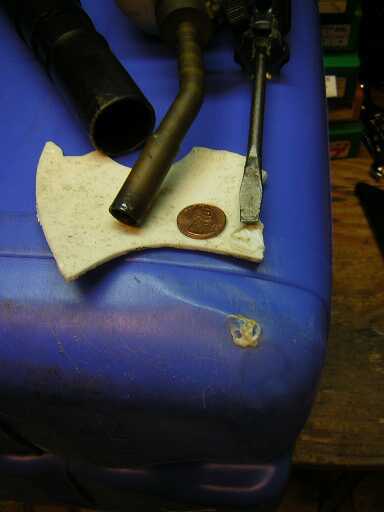 In preparation for a camping trip, I filled my 7-gallon HDPE (High-Density Polyethylene) plastic water container and put it in the back of my pickup. The camping trip didn't materialize, but I didn't take the big blue jug out of the truck. About a month later, I saw water beneath it. Lo and behold it was almost empty due to a leak. In preparation for a camping trip, I filled my 7-gallon HDPE (High-Density Polyethylene) plastic water container and put it in the back of my pickup. The camping trip didn't materialize, but I didn't take the big blue jug out of the truck. About a month later, I saw water beneath it. Lo and behold it was almost empty due to a leak.A quick look showed the cause—the truck must have hit a bump—the big blue jug bounced and landed hard—it now had a dent in the bottom edge—the dent leaked. My first thought was to simply patch the hole with epoxy, but epoxy doesn't stick to HDPE. A web search turned up the only way to patch HDPE—weld it. So that's what I did. I found a broken 5-gallon plastic bucket marked with the HDPE recycle symbol shown above. My trash had some empty quart motor oil containers also made of HDPE, but as they contained traces of oil I went with a chunk of the clean 5-gallon bucket Below, see the things I used. Not shown is a piece of sandpaper, a clean rag and a cup of soapy water.
I used the rounded end of a broom handle and pounded out the dent as best I could. To find the hole, I put the vacuum cleaner on "Blow," and with a rag wrapped around the nozzle as a gasket, I stuck the nozzle in the jug opening and pressurized the jug. Soapy water across the dent quickly produced bubbles and the location of the hole. Just like finding a leak in a tire. I marked a small circle around the hole, then dried it and buffed it with sandpaper to give the weld a grab. While the screwdriver blade tip heated over the propane torch, I put the vacuum cleaner on "Suck" and put a negative pressure inside the big blue jug. The blade tip hot, I stuck it in the chunk of white HDPE bucket and melted a daub across the blade. Look directly beneath the tip of the screwdriver blade at the chunk of white bucket, and you'll see the source of the daub. Then I simply touched the hot daub of white HDPE to the hole. The negative pressure sucked hot plastic inside the big blue jug and sealed the hole. It took way longer to describe the process than to do it.
|
